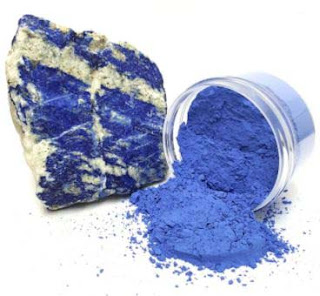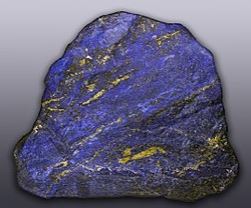In London’s National Gallery is an unfinished oil on wood panel, The Entombment, by Michelangelo. Many of the unfinished parts of the painting, such as the cloak of the missing Virgin, would have required quantities of the expensive blue pigment ultramarine made from powdered lapis lazuli, the only blue worthy of the Virgin Mary’s robe.
It’s possible that lapis lazuli was in short supply and had not arrived from his patron, which could explain why the painting was not completed before Michelangelo’s departure from Rome to Florence in 1501.
It’s possible that lapis lazuli was in short supply and had not arrived from his patron, which could explain why the painting was not completed before Michelangelo’s departure from Rome to Florence in 1501.
 Definition and Composition
Definition and Composition
Cennino Cennini said of ultramarine in his Book of Arts in 1400, “A noble color, beautiful, the most perfect of all colors.” Ultramarine is a deep blue pigment, originally made by grinding lapis lazuli into a powder. The name is Latin for ultramrinus, meaning “beyond the sea.”
Lapis lazuli is a mixture of the minerals calcite, sodalite, pyrite, and lazurite. Finer grades contain more sulphur, which produces a violet color, while inferior grades contain more calcium carbonate, giving it a grayish tone. The impurities are removed in the processing to produce the pigment.
History
Between the eleventh and eighteenth centuries, the main west-east axis, the Silk Road, brought Asian materials, including silk, inventions and art to Europe. The Silk Road consisted of land routes connecting East Asia and Southeast Asia with South Asia, Persia, the Arabian Peninsula, East Africa and Southern Europe. Mediterranean trade between the Middle East and North Africa and Europe in the twelfth through fourteenth centuries was conducted largely by Italian and Greek maritime republics.
During this period, Italian traders introduced lapis lazuli to Europe from Afghanistan, most notably, from ancient mines in Sar-e-sang, the “Place of the Stone,” a settlement in the Kuran Wa Munjan District of Badakhshan Province. Today, it can be found in other locations including Asia, America, Chile, Zambia, and Siberia but only a couple of Afghan mines produce the highest grade (a very deep purplish blue) of this unique stone. In 1826, French chemist Jean-Baptiste Guimet created a synthetic version of ultramarine by heating kaolinite, sodium carbonate and sulfur. The result was a more vivid color and less expensive to produce than traditional ultramarine. The new color was named French Ultramarine.

During this period, Italian traders introduced lapis lazuli to Europe from Afghanistan, most notably, from ancient mines in Sar-e-sang, the “Place of the Stone,” a settlement in the Kuran Wa Munjan District of Badakhshan Province. Today, it can be found in other locations including Asia, America, Chile, Zambia, and Siberia but only a couple of Afghan mines produce the highest grade (a very deep purplish blue) of this unique stone. In 1826, French chemist Jean-Baptiste Guimet created a synthetic version of ultramarine by heating kaolinite, sodium carbonate and sulfur. The result was a more vivid color and less expensive to produce than traditional ultramarine. The new color was named French Ultramarine.







No comments:
Post a Comment